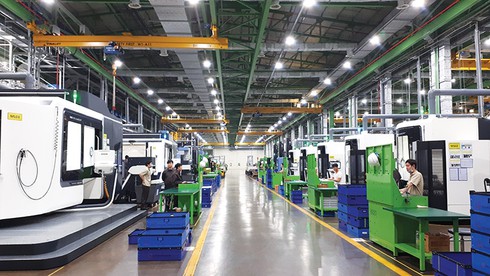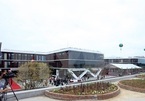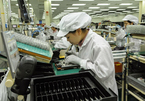 |
|
Investors’ indifference about high-tech parks has been partly blamed on legal obstacles, as well as a lack of social infrastructure
|
Completed infrastructure surrounded with trees and spacious buildings and accompanied with favourable transport links are the first notable changes at Hanoi’s Hoa Lac High-tech Park (HHTP) this year. Located about 30km from the city’s centre, the facility has marked a year of mass production of aero engines for South Korea’s Hanwha Group at the first foreign-invested aircraft engine parts factory, worth $200 million.
“We made revenues of $35 million in 2019, and are expected to increase this to $52 million this year. We are making a good performance there,” said general director Kam Sang Kyun of Hanwha Aero Engines, a subsidiary of South Korean conglomerate Hanwha Group.
Hanwha Areo Engines is one of very few major foreign-invested projects that HHTP has attracted in recent years, despite the effects of Decree No.74/2017/ND-CP which came into effect in 2017, governing the special mechanisms and policies for HHTP.
Why less attractive?
According to the HHTP Management Board, the park lured in just four domestically-invested projects in 2019, registered at VND7.46 trillion ($324.3 million), thus increasing its accumulative registered total capital to VND86.37 trillion ($3.76 billion) in 91 projects. The park had no foreign-invested project during the year, despite having meetings with around 70 delegations of international investors, and 30 other domestic equivalents.
“With the sum, we met the whole-year investment attraction target of $300 million, but have yet to meet expectations of attracting investment in social infrastructure such as workers’ housing, hospitals, trade centres, and other services,” Tran Dac Trung, director of HHTP’s Co-operation and Investment Division, told VIR.
HHTP attracted 11 projects in 2018 registered with VND17 trillion ($739 million), a record high over the past 20 years. Notable names involved included Nidec, Mitsubishi, and Hanwha Group.
Currently, the filling rate of the park is 30 per cent of its 1,500 hectares, while foreign direct investment (FDI) accounts for 30 per cent of total investment.
The figures show wavering attraction of the park, which was founded in 1998 and boasts the longest history among the country’s three high-tech parks. HHTP has more lucrative advantages than the other parks thanks to Decree 74, which includes unique incentives such as the 10 per cent corporate income tax (CIT) within the first 30 years for a new investment project of at least VND4 trillion ($174 million).
Thus far, only Hanwha Areo Engines is enjoying the special incentive. Japan’s Nidec is likely to follow, but can only access the incentive after this year when it completes investment disbursement and procedures with tax agencies.
The HHTP Management Board partly blamed legal barriers for the situation, especially regulations on refund of site clearance cost that investors use pocket money in advance. The other is a lack of social infrastructure – looking around HHTP, it can be seen that the necessary facilities for this area are still absent.
Similarly, the performance of Saigon High-tech Park (SHTP) and Danang High-tech Park (DHTP) has not been as high as expected. In particular, SHTP saw just one big foreign-invested project last year – the $650 million from Hong Kong’s Techtronic Industries, licensed towards the end of the year.
Although that project helps SHTP surpass the whole-year FDI attraction target and contributed 8 per cent to the city’s total, FDI at the park itself was modest in the first 11 months, with the biggest such project licensed being worth $5 million.
Located in Ho Chi Minh City, SHTP is the most successful attractor of international investment among the country’s three national high-tech parks. In 2018 it was estimated to have lured in $150 million worth of FDI.
Le Bich Loan, deputy director of the SHTP Management Board, told VIR previously that the park missed many options because of limited land funds. It is seeking to expand the park by 200ha to seize opportunities.
Meanwhile, DHTP lured in $178 million in total in 2019, thus increasing the total accumulative registered capital of $337 million in FDI. The projects in operation are the aerospace manufacturing factory of the US-based Universal Alloy Corporation, Tokyo Keiki Precision Technology, Japan’s NIWA Foundry, ESTEC, and ICT VINA medical device factory for South Korea.
DHTP also has special incentives for investors such as land lease fees, refund of site clearance cost, CIT, import duty, and credit, among others.
Industry insiders said that the three high-tech parks now have the advantage in attracting investors thanks to completed infrastructure, favourable transportation, and incentive policies. The problem here is how to implement more effective promotion campaigns to lure in investors.
Moreover, the high-tech parks in Vietnam are operating like an industrial park rather than a sci-tech hub. “To increase their attractiveness, together with effective special incentives, the high-tech parks should have a dynamic working environment, as well as modern and synchronous infrastructure,” said one expert.
Future solutions
In an effort to improve FDI attraction, HHTP is working with relevant governmental agencies on the amendments to laws on investment, enterprises, land, and personal income tax, along with relevant decrees. The park also plans to co-operate with the Ministry of Finance in revising Decree No.35/2017/ND-CP issued in 2017 on collection of land leasing fee in economic zones and high-tech parks to facilitate refund of site clearance cost.
This year, HHTP will intensify co-operation with international organisations such as the Japan International Cooperation Agency, the Japan External Trade Organization, the Korea Trade-Investment Promotion Agency, and others to promote investment opportunities at home and abroad. The park aims to call for investment and complete procedures. Currently it is processing procedures to grant investment certificates to 10 projects, including housing and social services. It also plans to develop workshops for lease.
In similar moves, Danang will organise investment promotion programmes abroad, including Europe, Japan, the Republic of Korea, the United States, Canada, India, Taiwan, and Singapore, for DHTP and industrial parks.
Notably, DHTP has signed an MoU with Ai20X Silicon Valley on co-operation in the promotion of American investment in DHTP, and in developing DHTP into an innovation and incubation centre. Also, experts of Ai20X Silicon Valley will give advice to schemes related to high-tech industrial sectors, innovations, and startups in Danang.
According to the Ministry of Planning and Investment, sci-tech is one of the four most attractive sectors to foreign investors, with total registered investment of $1.57 billionin 2019.
With the EU-Vietnam Free Trade Agreement being set to go live this year, and the government’s supporting programme to come out in line with Industry 4.0, the FDI picture at the three high-tech parks may be brighter as technology firms from Japan, the US, South Korea, and Europe are making business and investment plans in Vietnam, on the back of their countries’ new policies.
Thus far, the US has announced the US-ASEAN Smart Cities Partnership, the Republic of Korea’s President Moon Jae-in announced the New Southern Policy, and Japan piloted the Nurturing New Industries scheme within the ASEAN. VIR

Four million-dollar projects land in Hoa Lac Hi-tech Park this year
The Hoa Lac Hi-tech Park is currently home to 91 projects which have combined investment approvals of over VND85.8 trillion (nearly US$3.7 billion).

Vietnam faces bumpy road to be attractive destination for hi-tech investors
With limited resources, this is now time for Vietnam to consider placing importance on high-quality capital in order to elevate its labor qualification, technology and protect the environment.
 Despite the growing interest among international tech firms, overseas investment in Vietnamese high-tech parks in 2019 remained lacklustre, and solutions will need to be found in order to create an upward trend.
Despite the growing interest among international tech firms, overseas investment in Vietnamese high-tech parks in 2019 remained lacklustre, and solutions will need to be found in order to create an upward trend.